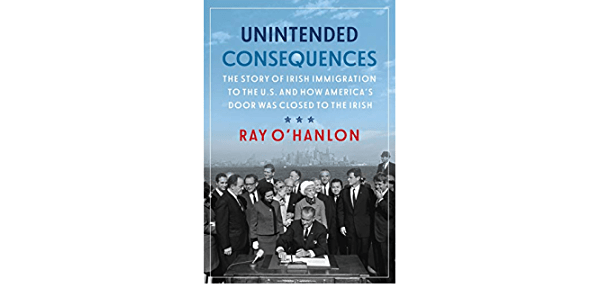Unintended Consequences: The story of Irish Immigration to the US and how America’s door was closed to the Irish
by Ray O’Hanlon (Merrion Press, €19.95)
Joe Carroll
For over 150 years the Irish crossed the Atlantic to make a new life in the United States and nobody shouted ‘stop’. Then in 1965 the open door narrowed to a crack and since then a struggle has gone on to get more American visas or green cards and legalise the thousands of Irish who ignore the rules and stay on in the US illegally.
The story is full of ironies and the author, who has covered the saga for many years as a reporter and editor for the Irish Echo in New York, tells it well. In 1963, President John F Kennedy made a triumphant tour of Ireland extolling the feats of Irish emigrants like his own family in the land of hope and glory. Yet a month later he sent congress his plan for a total reform of immigration policy which had the ‘unintended consequence’ of reducing the Irish traffic across the Atlantic to a trickle.
Change
After his assassination, the baton for change was taken up by his brother, Senator Edward Kennedy, who shepherded the legislation through the senate and was there when President Lyndon Johnson signed it into law on the hallowed soil of Ellis Island on October 3, 1965.
Another irony is that Senator Kennedy was to spend much sweat until his death in 2009 trying to undo the parts of the law that were keeping the Irish out. Successive Irish governments from the 1980s on would strive to get bigger quotas for the Irish and an amnesty for the ‘illegals’ or ‘undocumented’ whose estimated number would vary wildly from 40,000 to over 100,000 as nobody knew the correct figure.
Another irony is that the legendary Tip O’Neill, onetime speaker of the House of Representatives, would later reveal that the then Irish ambassador William Fay had urged congress members to vote for the 1965 act. There was fear in Dublin of a ‘brain drain’ of qualified Irish to the US just as the Irish economy was having its first expansion since independence. Even American bishops, many of Irish origin, favoured the reform as it would mean more Catholic arrivals from Latin America.
Recession
By the 1980s, the Irish economy was in recession and the jobless were again heading for New York and Boston. President Kennedy’s reform was a liberal effort to correct the often racist prejudice that inspired the immigration laws biased towards white English-speaking Europeans from Britain and Ireland. Because such large numbers of Irish had been entering the US in the 19th Century, Ireland was to be greatly favoured when a first reform of the laws in 1924 brought in quotas based on ‘national origins’. The Irish had a quota of almost 30,000 while the Italians had only 6,000. African, Asian and Latin American countries need not apply.
By 1965, the Irish and British were not filling their generous quotas. The 1965 act changed all that. National quotas were replaced by qualifications and ‘family reunification’ which favoured Italians, Poles, Greeks, etc. The author documents the long struggle by Irish-American organisations to get in more Irish compatriots. There were ‘Donnelly visas’, ‘Morrison visas’, ‘Berman visas’ and other ploys to increase the Irish quota marginally but there was to be no amnesty for the ‘undocumented’ who were increasingly liable to be rounded up and deported. Bertie Ahern when Taoiseach in 2008 said bluntly in Washington that “an amnesty is not on”. Recent ministers have been more diplomatic.
Teddy Kennedy died regretting the ‘unintended consequences’ to the Irish of what he and his brother had done. His efforts to undo them were thwarted by the byzantine rules needed to get reforms through both houses. Immigration became an even hotter potato during the Donald Trump years. Ray O’Hanlon’s account is a valuable history of a reform gone wrong, at least for the Irish.



